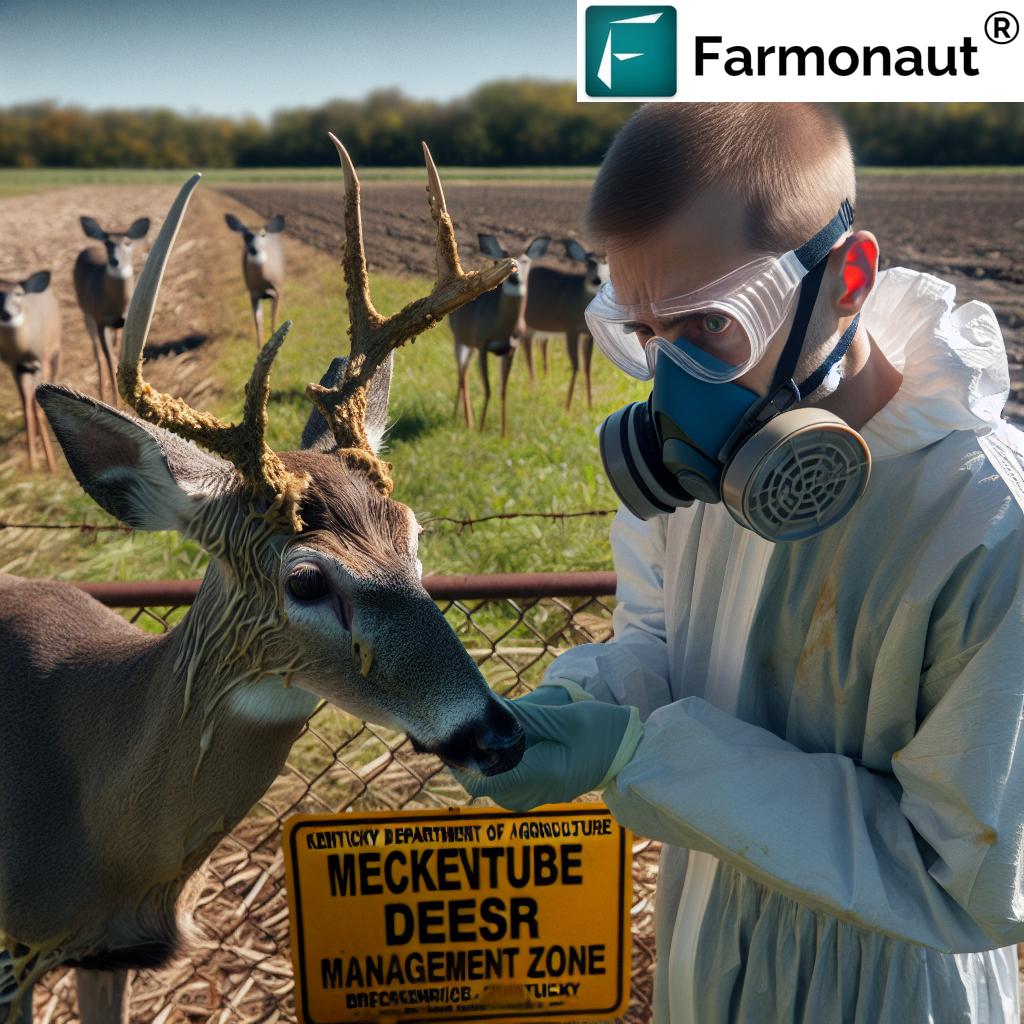Alarming Discovery: Kentucky’s Zombie Deer Disease Outbreak Sparks Urgent Action and Wildlife Health Crisis
A recent outbreak of Chronic Wasting Disease (CWD), commonly known as “zombie deer disease,” has sent shockwaves through Kentucky’s wildlife community, prompting immediate action from state officials and raising concerns about the long-term health of the region’s cervid population.

The Emergence of CWD in Kentucky
The Kentucky Department of Agriculture has confirmed the first case of Chronic Wasting Disease in the state, specifically in Breckinridge County. This alarming discovery has thrust Kentucky into the growing list of states grappling with this always-fatal cervid disease, which now affects over half of the United States.
CWD, colloquially referred to as “zombie deer disease” due to its devastating effects on infected animals, is a progressive neurological disorder that affects deer, elk, and moose. The disease earned its unsettling nickname from the symptoms it causes, including drastic weight loss, stumbling, listlessness, and a lack of fear of humans.
Immediate Response and Containment Efforts
In response to the CWD detection in Breckinridge County, state officials have swiftly implemented a series of measures to contain and manage the outbreak:
- Deer Farm Quarantine: The affected deer farm in Breckinridge County has been placed under immediate quarantine to prevent the potential spread of the disease.
- CWD Management Zone: A designated CWD management zone has been established around the affected area to monitor and control cervid movement.
- Intensified Surveillance: Enhanced deer herd surveillance protocols have been put in place to detect any further cases of the disease.
The State Veterinarian has taken a leading role in coordinating these efforts, working closely with wildlife biologists and local authorities to implement these crucial measures.
Understanding Chronic Wasting Disease
Chronic Wasting Disease is a type of transmissible spongiform encephalopathy (TSE), similar to mad cow disease in cattle and scrapie in sheep. The disease is caused by abnormally folded proteins called prions, which cause severe and irreversible damage to the brain and nervous system of infected animals.
Key facts about CWD:
- It is always fatal, with no known cure or vaccine
- The disease can incubate for over a year before animals show symptoms
- CWD can spread through direct animal-to-animal contact or indirectly through contaminated environments
- Prions can persist in the environment for years, making eradication extremely challenging
The discovery of CWD in Kentucky marks a significant turning point in the state’s wildlife management efforts and underscores the need for heightened vigilance in monitoring and protecting cervid populations.
Impact on Kentucky’s Wildlife and Economy
The presence of Chronic Wasting Disease in Kentucky poses a severe threat not only to the state’s wildlife but also to its economy. Hunting and wildlife tourism contribute significantly to Kentucky’s rural economies, and the spread of CWD could have far-reaching consequences.
Potential impacts include:
- Decline in deer populations, affecting ecosystem balance
- Reduced hunting opportunities and associated economic losses
- Increased costs for wildlife management and disease control
- Potential effects on related industries such as taxidermy and meat processing
To stay informed about the latest developments in this Kentucky wildlife health crisis, residents and stakeholders are encouraged to regularly check the Kentucky Department of Agriculture’s website for updates and wildlife health alerts.

Zombie Deer Disease Prevention and Public Awareness
As Kentucky grapples with this new threat, public awareness and cooperation are crucial in preventing the further spread of CWD. The Kentucky Department of Agriculture, in collaboration with wildlife agencies, has launched an extensive public education campaign to inform residents about the disease and the steps they can take to help combat its spread.
Key prevention strategies include:
- Avoiding the transportation of deer carcasses from affected areas
- Properly disposing of deer remains in designated areas
- Reporting any sick or abnormally behaving deer to wildlife authorities
- Following all hunting regulations and guidelines set by the state
Hunters and outdoor enthusiasts are particularly urged to familiarize themselves with the signs of CWD and to participate in voluntary testing programs when available.
The Role of Technology in Disease Management
In the fight against Chronic Wasting Disease, cutting-edge technology is playing an increasingly important role. Satellite imagery and remote sensing tools, such as those provided by Farmonaut, are being utilized to monitor wildlife habitats and track the movement of cervid populations.
These advanced technologies allow wildlife managers to:
- Identify potential disease hotspots
- Monitor changes in deer population densities
- Assess habitat conditions that may influence disease spread
For those interested in leveraging such technologies for wildlife management or agricultural purposes, Farmonaut offers a range of solutions:
Access Farmonaut’s services:
Explore Farmonaut’s API: https://sat.farmonaut.com/api
API Developer Documentation: Farmonaut API Docs
Looking Ahead: Long-term Management and Research
As Kentucky embarks on its journey to manage and potentially eradicate Chronic Wasting Disease within its borders, long-term strategies are being developed. These include:
- Continued surveillance and monitoring of deer populations
- Research into potential treatments or preventive measures for CWD
- Collaboration with neighboring states to coordinate disease management efforts
- Evaluation and potential modification of wildlife management practices
The discovery of CWD in Kentucky serves as a stark reminder of the interconnectedness of ecosystems and the importance of proactive wildlife health management. As the situation evolves, the commitment of state agencies, researchers, and the public will be crucial in navigating this unprecedented challenge to Kentucky’s wildlife.
Conclusion
The outbreak of Chronic Wasting Disease in Kentucky marks a critical moment for the state’s wildlife management efforts. As officials work tirelessly to contain and manage the spread of this “zombie deer disease,” the cooperation of all stakeholders – from hunters and landowners to the general public – will be essential in protecting Kentucky’s cherished cervid populations.
By staying informed, following guidelines, and supporting ongoing research and management efforts, Kentuckians can play a vital role in safeguarding the health of their wildlife and preserving the state’s rich outdoor heritage for future generations.
For those looking to contribute to wildlife monitoring efforts or integrate advanced technologies into their land management practices, consider exploring the tools offered by Farmonaut:
As Kentucky faces this wildlife health crisis, the resilience and adaptability demonstrated by its communities and wildlife management professionals offer hope for effectively managing the challenges posed by Chronic Wasting Disease. Through collaborative efforts, innovative approaches, and ongoing vigilance, Kentucky aims to protect its diverse and valuable wildlife resources for years to come.
















